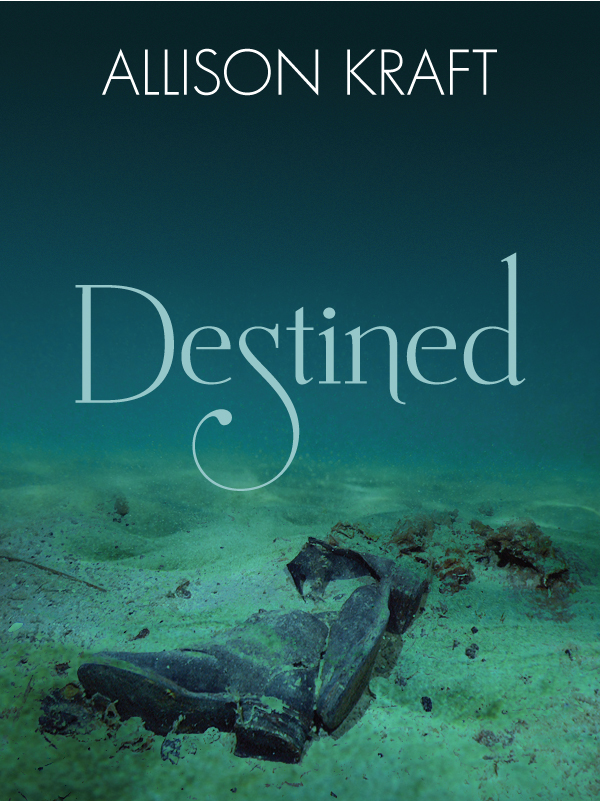Before I get to the post, some news: if you’d like a chance to win a copy of Destined, check out this great giveaway being hosted at Starcrossed Reviews. The lucky winners will not only get a copy of Destined (paperback for US winners, ebook for International), but a whole lot of other great books (about 20 in total). Contest rules and details are at the link above. Starcrossed gave Destined a fantastic 5-star review not too long ago, in case you missed it.
Also, it looks like the ebook for Destined has finally been sent to Kobo, for those who were waiting for it to be available for that reader. I’m still waiting for it to show up in their catalog, but am hoping it won’t be much longer. I will post to Facebook/Twitter when it finally becomes available there. I apologize again for the delay. Apparently Kobo was seriously backlogged.
Now that the news and promos are out of the way, I can get on to the actual post. Which I am now writing about an hour after the first part, due to discovering that my scanner no longer works on my new computer. (Apparently Canon couldn’t bother themselves to make Windows 7 drivers for it.) So now I either need to buy a new scanner or a new printer that has a scanner included. The last time I bought a new printer, I intentionally didn’t get the all-in-one kind because I already had a perfectly good flatbed scanner. It seemed like overkill (and a waste of money) to buy one with a scanner when I didn’t need that feature. Now I feel like it’s silently taunting me.
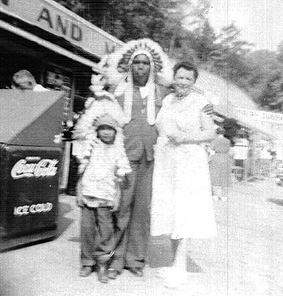 So what was all the scanning fuss about? I got a card this week from a cousin I reconnected with a few years back while doing genealogy research on my dad’s side of the family. She sent along some old photos another cousin found that included my great grandmother, and while it was neat to see some new (to me) photos of her, it reminded me just how important it is to label your family photos. The few that were written on were mostly just names, and I suspect those were written recently rather than at the time they were developed. The caption on this one? “Sylvia & Indian.” I have no Native American blood in my family (that I know of), except for way, way, way back on my mother’s side. I have ancestors there who, in 1704, were attacked by a tribe of Caughnawagas (a branch of the Mohawks, I believe) and had four of their sons captured and taken to Canada. One son was later bought back by the family, while the other 3 were left behind and grew up with the Indians, eventually assimilating into the tribe. One was even adopted as the chief’s son, if the stories are correct. But anyway, that’s not my dad’s side of the family, so I can only imagine the photo here was taken on some kind of vacation. There’s another photo of her and the older Indian, without the younger boy, one of her with two of her cousins in front of the same store, and another of her by herself in what appears to be the same outfit, standing at a wooden railing overlooking some kind of gorge or waterfall. No sign of her husband or son around, even though she’s old enough that they’d both be in the picture (no pun intended).
So what was all the scanning fuss about? I got a card this week from a cousin I reconnected with a few years back while doing genealogy research on my dad’s side of the family. She sent along some old photos another cousin found that included my great grandmother, and while it was neat to see some new (to me) photos of her, it reminded me just how important it is to label your family photos. The few that were written on were mostly just names, and I suspect those were written recently rather than at the time they were developed. The caption on this one? “Sylvia & Indian.” I have no Native American blood in my family (that I know of), except for way, way, way back on my mother’s side. I have ancestors there who, in 1704, were attacked by a tribe of Caughnawagas (a branch of the Mohawks, I believe) and had four of their sons captured and taken to Canada. One son was later bought back by the family, while the other 3 were left behind and grew up with the Indians, eventually assimilating into the tribe. One was even adopted as the chief’s son, if the stories are correct. But anyway, that’s not my dad’s side of the family, so I can only imagine the photo here was taken on some kind of vacation. There’s another photo of her and the older Indian, without the younger boy, one of her with two of her cousins in front of the same store, and another of her by herself in what appears to be the same outfit, standing at a wooden railing overlooking some kind of gorge or waterfall. No sign of her husband or son around, even though she’s old enough that they’d both be in the picture (no pun intended).
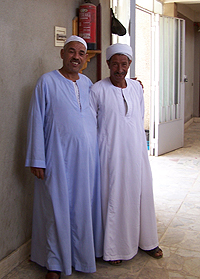 I can’t help wondering, who were the Indians? Did she know them, or were they just hanging around the store, posing for photos with strangers, the way Egyptians do? (Photo to the right is from a trip I took to Egypt in 2005. I have no idea who these two men are. They posed for my father while we were touring an old site and soon as he took the photo, they demanded a tip.) I can’t help wondering what my descendants will think 60-70 years or so from now when they look at my photos? I suspect they’ll be seriously confused, since I hate to be photographed, and the few photos I am in tend to include minor celebrities (I went through a big soap opera phase a while back and have stacks of pictures of myself with actors from General Hospital.). The photos I’ll be passing down will be mostly scenery from vacations and cats. And none are labeled, either.
I can’t help wondering, who were the Indians? Did she know them, or were they just hanging around the store, posing for photos with strangers, the way Egyptians do? (Photo to the right is from a trip I took to Egypt in 2005. I have no idea who these two men are. They posed for my father while we were touring an old site and soon as he took the photo, they demanded a tip.) I can’t help wondering what my descendants will think 60-70 years or so from now when they look at my photos? I suspect they’ll be seriously confused, since I hate to be photographed, and the few photos I am in tend to include minor celebrities (I went through a big soap opera phase a while back and have stacks of pictures of myself with actors from General Hospital.). The photos I’ll be passing down will be mostly scenery from vacations and cats. And none are labeled, either.
I think part of the reason I got so interested in genealogy was because I’m a writer. I love uncovering stories about people I never knew existed, or learning new things about the people I did know. A perfect example is a story I learned about my great grandmother (the one posing with the Indians). While researching her family, I came across a census record that showed a child in the household named Georgiana. I had never heard of my great grandmother having a sister: just two brothers. I asked my father, who also hadn’t heard of her, which made it even stranger as he was very close to that side of his family. Georgiana wasn’t on the next census with her family, but she would have been 21 that year, so it was possible she’d married. Still, it was strange that she vanished so completely, and the online marriage records for Chicago end in 1920, so I couldn’t find anything there. There were no death records matching her maiden name, so if she had died young, I found no proof. She just disappeared! Or so it seemed. And then I found this photo in my grandparents’ things:
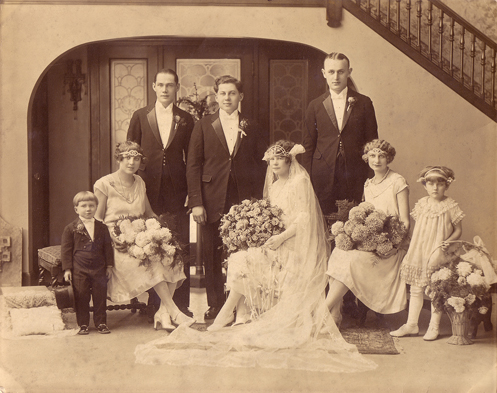
The only writing on it was Sylvia’s father’s name and address on the back. It wasn’t Sylvia’s wedding: we knew what she looked like. It also didn’t look like her brother, Anton, or youngest brother, John. We had no clue who this was. The style of clothing was very 20s, but Georgiana was a teenager in the 20s, and I didn’t think it could be her. Sadly, my grandparents had already passed away by the time I started my research, so I couldn’t ask my grandfather. My father and aunt had vague memories of a story that went around about a family member who was killed, but weren’t sure what the details were. Eventually, between them searching their memories and reconnecting with the previously-mentioned cousin (who is the daughter of one of Sylvia’s brothers, and knew the true story from her father), we found out what happened. Georgiana was indeed their sister. She married young (that was her wedding photo after all) and had a son in 1927 at the age of 18 (perhaps that was why she married so young?). She and her husband later became separated, and she was preparing to divorce him, but he didn’t take too well to the idea and one day showed up at her house and shot her, their 2-year-old son and then himself. Her brother Anton was living in the apartment one floor above her and heard the shots. He left his own baby daughter (my cousin, who later told us the story) and his wife upstairs to go see what was happening, and found the bodies. Georgiana died on the way to the hospital. One of the family rumors says that her husband, Joe, had a priest in his family and confessed to him that he was going to kill his wife before going to her house. Back then, there were no laws requiring priests to go to the police with such confessions, so he wasn’t able to warn anyone. It makes for a good twist to the story, but I never found anyone in Joe’s immediate family that was a priest, so it may not have been true.Then again, he’s buried in a Catholic cemetery (Resurrection Cemetery, famous for Resurrection Mary), which strikes me as odd given that he was a suicide. Signs of a family connection to the Church, perhaps?
As for poor Georgiana, she’s buried in Chicago’s largest Bohemian cemetery (that side of my family is from Czechoslovakia), all by herself. The rest of the family is in a different cemetery, closer to where they later lived. It’s almost like her death was so traumatic, they tried to forget about her completely. I guess back then people didn’t talk about unhappy subjects, and this kind of family tragedy was kept secret. The only mention I ever found of her, other than a newspaper article about her murder (where all the names were misspelled, so it took some serious Google-fu to unearth!), was in one of her mother’s obituaries. Everywhere else, in obituaries of her siblings, father and others of her mother, she’s never mentioned. It’s kind of sad to think she was so close to being forgotten. And after learning her story, I can’t deny a part of me wants to write a book inspired by it. It would make for a good ghost story, don’t you think? The house is still there: when we visited Chicago last year, we found it and the paranormal-obsessed side of me couldn’t help jumping to the conclusion of “ooh, maybe it’s haunted!” It had a For Rent sign in the window, though, so no one was home. Not that I’d have the guts to knock on the door and ask.
Here’s a photo of Georgiana’s grave in the Bohemian cemetery. Jirinka is the Czech spelling of her name. The line at the bottom loosely translates to “here also rests my son,” so I can only assumed Joe Jr. was buried with her. Sad that he didn’t get his name on the headstone. Even sadder that the photo on the stone is the only one we have of him, and the only non-wedding photo we have of her.

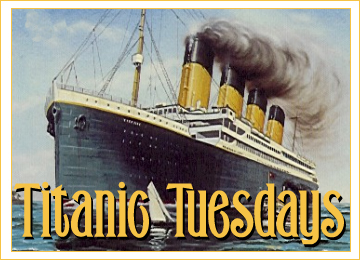
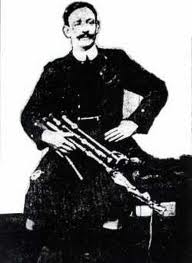 Another Irish passenger that has more information available, and connects more directly to my own book, is Eugene Daly. Daly was 29 years old when he boarded the Titanic in Queenstown, and was most known later for playing “Erin’s Lament” on his uilleann pipes (similar to bagpipes) while the ship left port. A third class passenger, he sat out on the bow and played, a somber farewell to his homeland. According to the Encyclopedia Titanica, his pipes went down with the ship, and he later filed a claim for them for $50. A set of pipes was salvaged from the wreck many years later that might have been his, but no one is certain.
Another Irish passenger that has more information available, and connects more directly to my own book, is Eugene Daly. Daly was 29 years old when he boarded the Titanic in Queenstown, and was most known later for playing “Erin’s Lament” on his uilleann pipes (similar to bagpipes) while the ship left port. A third class passenger, he sat out on the bow and played, a somber farewell to his homeland. According to the Encyclopedia Titanica, his pipes went down with the ship, and he later filed a claim for them for $50. A set of pipes was salvaged from the wreck many years later that might have been his, but no one is certain.
 So what was all the scanning fuss about? I got a card this week from a cousin I reconnected with a few years back while doing genealogy research on my dad’s side of the family. She sent along some old photos another cousin found that included my great grandmother, and while it was neat to see some new (to me) photos of her, it reminded me just how important it is to label your family photos. The few that were written on were mostly just names, and I suspect those were written recently rather than at the time they were developed. The caption on this one? “Sylvia & Indian.” I have no Native American blood in my family (that I know of), except for way, way, way back on my mother’s side. I have ancestors there who, in 1704, were attacked by a tribe of Caughnawagas (a branch of the Mohawks, I believe) and had four of their sons captured and taken to Canada. One son was later bought back by the family, while the other 3 were left behind and grew up with the Indians, eventually assimilating into the tribe. One was even adopted as the chief’s son, if the stories are correct. But anyway, that’s not my dad’s side of the family, so I can only imagine the photo here was taken on some kind of vacation. There’s another photo of her and the older Indian, without the younger boy, one of her with two of her cousins in front of the same store, and another of her by herself in what appears to be the same outfit, standing at a wooden railing overlooking some kind of gorge or waterfall. No sign of her husband or son around, even though she’s old enough that they’d both be in the picture (no pun intended).
So what was all the scanning fuss about? I got a card this week from a cousin I reconnected with a few years back while doing genealogy research on my dad’s side of the family. She sent along some old photos another cousin found that included my great grandmother, and while it was neat to see some new (to me) photos of her, it reminded me just how important it is to label your family photos. The few that were written on were mostly just names, and I suspect those were written recently rather than at the time they were developed. The caption on this one? “Sylvia & Indian.” I have no Native American blood in my family (that I know of), except for way, way, way back on my mother’s side. I have ancestors there who, in 1704, were attacked by a tribe of Caughnawagas (a branch of the Mohawks, I believe) and had four of their sons captured and taken to Canada. One son was later bought back by the family, while the other 3 were left behind and grew up with the Indians, eventually assimilating into the tribe. One was even adopted as the chief’s son, if the stories are correct. But anyway, that’s not my dad’s side of the family, so I can only imagine the photo here was taken on some kind of vacation. There’s another photo of her and the older Indian, without the younger boy, one of her with two of her cousins in front of the same store, and another of her by herself in what appears to be the same outfit, standing at a wooden railing overlooking some kind of gorge or waterfall. No sign of her husband or son around, even though she’s old enough that they’d both be in the picture (no pun intended). I can’t help wondering, who were the Indians? Did she know them, or were they just hanging around the store, posing for photos with strangers, the way Egyptians do? (Photo to the right is from a trip I took to Egypt in 2005. I have no idea who these two men are. They posed for my father while we were touring an old site and soon as he took the photo, they demanded a tip.) I can’t help wondering what my descendants will think 60-70 years or so from now when they look at my photos? I suspect they’ll be seriously confused, since I hate to be photographed, and the few photos I am in tend to include minor celebrities (I went through a big soap opera phase a while back and have stacks of pictures of myself with actors from General Hospital.). The photos I’ll be passing down will be mostly scenery from vacations and cats. And none are labeled, either.
I can’t help wondering, who were the Indians? Did she know them, or were they just hanging around the store, posing for photos with strangers, the way Egyptians do? (Photo to the right is from a trip I took to Egypt in 2005. I have no idea who these two men are. They posed for my father while we were touring an old site and soon as he took the photo, they demanded a tip.) I can’t help wondering what my descendants will think 60-70 years or so from now when they look at my photos? I suspect they’ll be seriously confused, since I hate to be photographed, and the few photos I am in tend to include minor celebrities (I went through a big soap opera phase a while back and have stacks of pictures of myself with actors from General Hospital.). The photos I’ll be passing down will be mostly scenery from vacations and cats. And none are labeled, either.









